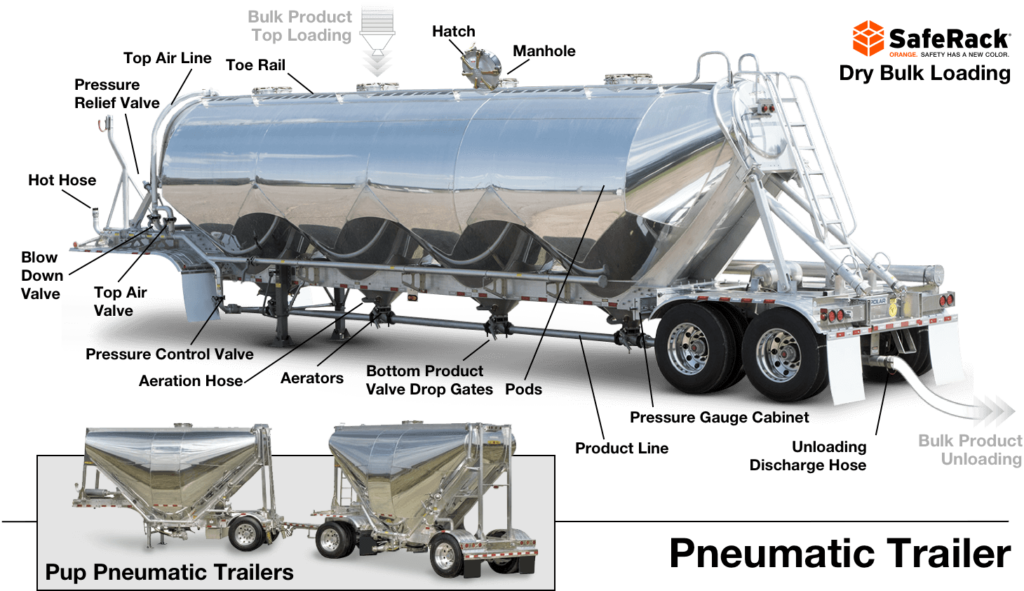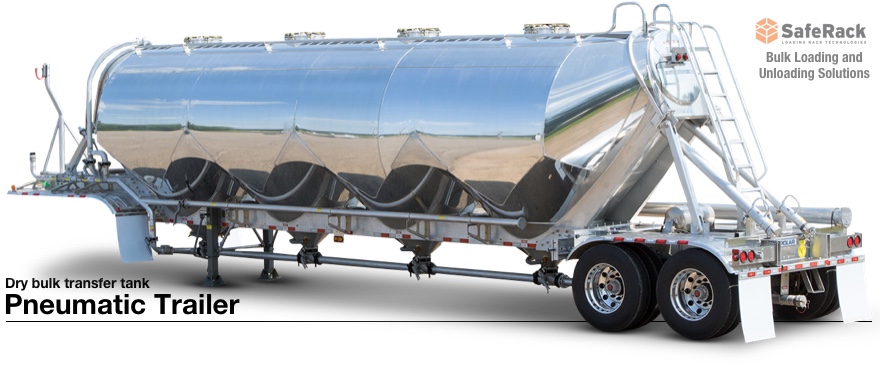Right now, you’re probably surrounded by items made of plastic—phones, pens, eyeglasses, yogurt cups, you name it. Practically every ounce of that plastic started as a load of resin pellets or powder transported in dry bulk tanks. Not only are Pneumatic Trailers used for transporting pellets, but also used for grains, sugar, cement aggregate… essentially any dry substance that needs to be transported.
Dry bulk shipping is an important component of today’s supply chains, but transporting it is no simple matter. Even if you’ve shipped these kinds of products in boxes, drums, or totes in a dry van, that doesn’t prepare you for the challenges of managing tank loads of dry bulk with safety cages for fall protection.
The Pneumatic Trailer (aka “dry bulk tank”) is basically a metal cylinder with a series of cone-shaped hoppers. A series of openings (or “manholes”) at the top of the hopper is for loading dry bulk and is typically gravity fed from a silo. At the bottom of each hopper car (or “Pod”) is a valve, opening into a pipe that runs below the trailer. Those valves are closed when a shipper loads the truck. When it comes time to unload, the driver opens them, letting the product run out of the hopper and into the pipe. A compressor on the truck fluidized the dry bulk material, as opposed to dry bulk bags, and force it out of the discharge hose and into a silo.
Dry bulk carriers pay a lot for their equipment—about $110,000 for a tank that carries sand and clay and up to $140,000 for a trailer with a special vacuum unit for plastics. Other equipment for on- and off-loading costs extra. By way of contrast, a dry van trailer costs $35,000-$40,000.

The biggest concern for these carriers?
Contamination. A responsible carrier diligently visits the truck wash after each load, but there’s always a chance that a little stray material—a few beads of plastic or a bit of clay residue—will survive the wash, stuck deep in the piping (note: there are more extensive methods of tank washing that can further prevent this). What happens then? Picture a load of white plastic pellets shipped in a trailer that still has a few black pellets lodged in a crevice. If those black pellets get dislodged, they’ll mix in with the white product. Then, when that plastic goes through a manufacturing process—say, to produce shampoo bottles—you’ll get an ugly black slash across hundreds of units. The customer will have to toss those bottles, and someone—possibly you, the shipper—will pay for that loss.
Learn more about SafeRack pneumatic truck unloading systems
The problem can be even worse if, instead of production, the load goes into a silo already filled with white beads. Those few black beads could ruin hundreds of thousands of pounds of white plastic. Because of this, many carriers that move bulk plastic pellets reserve some trailers for white pellets, some for black, some for blue, and so on. They then dedicate other trailers to loads such as sand or clay.
























